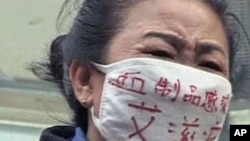At the coming AIDS conference in Vienna, experts will examine the state of the global fight against HIV. The United Nations says most Asian countries have an AIDS infection rate of less than one percent. But because of the large populations, that translates to almost five-million people living with HIV. Health experts say the key to preventing a widespread epidemic in Asia is to reach out to people engaging in high-risk behaviors.
Rasta, like many first-time patients at an AIDS clinic in Jakarta, is apprehensive.
She says she is afraid of what she might find out from the HIV test.
The clinic is one of the more than 700 facilities working to stem the rising HIV infection rate in Indonesia. Here, like in many parts of Asia, AIDS is concentrated within groups that participate in high-risk behaviors, such as sex workers, homosexual men and injecting drug users.
The U.S. Agency for International Development's HIV/AIDS advisor here, Lisa Baldwin, says while Indonesia has only a 0.1 percent HIV infection rate nationally, the rate for injecting drug users in Jakarta is 56 percent. For sex workers it is 16 percent.
Baldwin says working with these high-risk groups now could prevent a wider epidemic in Indonesia and many other parts of Asia.
"They are a population that could really be a bridging population to the more general community," said Baldwin. "So I think there is opportunity to really clamp down and keep this more contained but there are also opportunities for this to spill out."
In addition to taking blood samples and testing for HIV, the staff at the clinic also counsel clients to use condoms during sex and use sterile needles to prevent infection.
Some in the Islamic religious community object to these programs, which they say condone immoral behavior. But Nafsia Mboi, the secretary-general of the Indonesian National AIDS Prevention Commission, says its role is not to judge the patient but to treat and prevent the disease.
"While those that think this is a disease of sinners, I usually say, well they are still Indonesian, sinners or not sinners," Mboi said. "They are still Indonesian and they have the right to life and the right to health, the right to education and so that is our responsibility."
In China, the United Nations says 700,000 people live with HIV or AIDS. Chinese health officials say in the past, misinformation about how the disease spreads, discrimination and a lack of treatment made people reluctant to seek help.
But they say today education efforts like this public service announcement featuring basketball player Yao Ming have helped increase understanding.
And with support from international organizations like the Global Fund, antiretroviral drugs to treat AIDS are increasingly available in China and elsewhere in Asia.
These developments have encouraged more people in China to get tested. But Jiang, who is living with AIDS in Beijing and does not want his full name known, says the stigma of AIDS remains.
He says he has only told other patients and nurses about his condition because the pressure in society is too much.
Thailand is one of the few countries in Asia that has significantly reduced the spread of HIV and AIDS.
The World Health Organization says between 1989 and 1994 the number of new sexually transmitted disease cases among men treated at government clinics, plummeted by more than 90 percent.
Former Cabinet minister Mechai Viravaidya led the condom use promotion. His efforts include opening a restaurant called Cabbages and Condoms that gives diners condoms. But the AIDS activist says the Thai government's commitment was key to containing the disease.
"Firstly, there was political commitment and financial commitment," said Mechai. "All the money spent on HIV prevention or treatment in Thailand, 90 percent came from the government or from within the country. Only 10 percent from the outside. So many countries do not have the political or the financial commitment and expect the rest of the world to save you."
And with much of the region doing well economically, USAID's Baldwin says donors are expecting more Asian countries to take over funding AIDS programs soon.
"So you know, I think the donors are all prioritizing and one of the factors that is always considered is how much money is there within the local economy to be, should there be to contribute," Baldwin said.
In some countries, such as Indonesia, international donors provide 80 percent or more of the AIDS funding. Baldwin says that can not continue indefinitely.









